The polarity of the appliance is the most important component when connecting. If the polarity is reversed, the device may malfunction and lead to negative consequences. Typically, the positive and negative wires are labeled with letters, symbols, or color. But sometimes it is not possible to determine the belonging of the core, then they use testers in other ways.
- Wire classification options
- Why do you need to stain the veins
- Phase color
- Ground wire color
- Zero color
- Color of wires and tires with alternating three-phase current
- Features of working with electric wires of different colors
- How to check the correctness of labeling and wiring
- Checking with an indicator screwdriver
- Checking with a multimeter
- Determination of ground, zero and phase using a test lamp
- Self-marking
Wire classification options
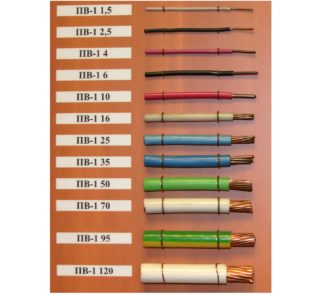
Conductors have two types of markings - color and alphanumeric. By these designations, you can understand what the product is made of, what is the purpose of the core, what material and other important parameters.
Wires can be classified according to the following indicators:
- Number of lived. Depending on the number of cores, the conductor can be used to provide the electric motor with power, wiring, transmission of electric current in power networks. Also, the flexibility of the product depends on the number of cores.
- Material. Copper is predominantly used to create live conductors, since it is more resistant and has good characteristics. Previously, aluminum was used - it quickly collapses, has a short service life and is inferior in properties to a copper device.
- Insulating layer. The conductor may or may not have insulation. It is made of dielectric material and protects the product from mechanical damage, external influences, as well as a person from electric shock.
- Section. The load that the cable is able to pass through itself depends on this indicator.
- Other indicators. Power, voltage, operating temperatures, operating conditions are also important for the selection of the conductor.
Thanks to the listed properties, you can choose the right wire for different purposes.
Why do you need to stain the veins
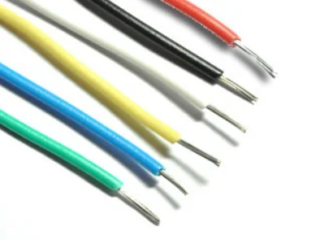
Novice masters who are just mastering the basics of electrical engineering cannot immediately determine whether a white wire is a plus or a minus. Coloring is important in identifying cores and is called marking.
Color coding of conductors is a necessity, allowing the craftsman to quickly navigate what each core is responsible for. With its help, you can understand what color the neutral wire is and where the phase is. It also makes electronic circuits easier to read.
It is especially important to observe color coding when connecting to meters, machines, devices. Without painting, it is difficult to figure out which device could fail and in which circuit it is connected.
Manufacturers paint cables in certain colors, established by the rules of electrical installations PUE. They strictly regulate which markings should be used for a particular core.
In addition, it is important to understand that the positive and negative contacts in the DC circuit have their own color. What color is the positive wire is also established by the rules.
In the case of unmarked cables of the same color, a label with information can be placed at the ends of the product (for example, on a heat-shrinkable tube).
Phase color
Usually the phase is colored red and black, but other colors (orange, brown, pink, purple, white, turquoise and others) can also be found.
If the electrician does not know exactly what color the phase is, you can use the elimination method. Neutral and grounding wires have a strictly defined color, and then the remaining core is a phase.
In the diagrams, the phase is indicated by the Latin letter L. If there are several of them, a number is added - L1, L2, L3 for three-phase networks of 380 V. The designation A, B and C is also found in power networks with three phases.
Ground wire color
Some manufacturers make a ground wire that is bright green or yellow. In this case, it is not difficult to identify the ground, since such a color is prohibited to indicate the phase. Similar markings are used on electrical circuits. Letter designation - PE.
Some experts incorrectly call the ground "neutral and protective" wire. This can confuse others, you need to understand that it is the earth wire that is hidden under this name. It is by definition protective, as it helps to protect a person from electric shock in the event of an emergency.
Zero color
The neutral or neutral wire is traditionally painted blue or light blue, but there is a blue color with a white stripe. No other shades are applied to scratch. Experts also call the zero conductor a working zero. This expression is correct, since it participates in the wiring with power.
In some circuits, zero can be called a minus, and a phase is a plus.
Color of wires and tires with alternating three-phase current
Such networks have found their application in the following areas:
- Industry, construction, warehousing. Allows you to connect powerful industrial installations, unloading machines and other electrical equipment.
- Public transport electrification. Trams and trolleybuses operate on a 380 V three-phase network.
- Electrical substations.
DC networks use only two wires - plus (positive rail) and minus (negative rail). Which wire is a plus and which is a minus can also be understood by the colors.
According to regulatory documents, the positive bus should be colored red, and the negative wire gray or black. The middle conductor is indicated in blue. You can see this designation of plus and minus on wires on various audio and video equipment, as well as other electronics.
In the case of a branch of a two-wire electrical network, the positive conductor must be colored in the same way as the plus on the three-wire network to which it is connected.
Features of working with electric wires of different colors
There are cases when knowledge of phase and zero is optional. For example, when connecting a new outlet or replacing an old one. When the plug is connected to it, the polarity is not important and does not affect the performance of the device.
In situations where you need to connect a switch to a chandelier, you need to know the phase and zero. The phase conductor is connected directly to the switch, and only zero is connected to the light bulbs. Otherwise, the switch will not work.
The use of conductors of different shades greatly facilitated the work of the craftsmen and accelerated the installation process. Also, color coding made it possible to increase safety when working with live conductors.
How to check the correctness of labeling and wiring
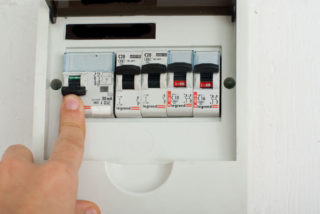
Color coding is simple and convenient, but you should not rely entirely on its correctness. In addition, over time, it can wear off, making it difficult to identify the wire. The difficulty lies in the old wires, which were monotonous - white or black. Therefore, before carrying out work, you should check what each core is responsible for.
It is important to de-energize the room before wiring. The wires at the ends should be slightly stripped, and only then checked with a tester. Otherwise, you may get an electric shock.
Checking with an indicator screwdriver
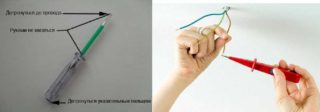
You will need a tester to work. This can be a multimeter or an indicator screwdriver. It looks like a regular screwdriver on the outside, but there is an LED indicator at the end. Its handles are necessarily insulated. It's easier to work with a screwdriver - just touch each core, and if the probe hits a phase, the LED indicator should light up. This method is suitable for two-core wires. The main disadvantage of determining the phase with an indicator screwdriver is the risk of false triggering. It can react to interference and show the presence of voltage where there is none.
You can buy the device at any hardware store. It is inexpensive and accessible to everyone, unlike professional testers.
Checking with a multimeter

A multimeter is needed for a three-core wire. Then you can go by the way of elimination - find the exact phase with a screwdriver, and then determine the ground and zero with a tester.
There are two types of multimeters - digital and analog. The difference is only in the information output, the verification accuracy and the internal mechanism. The test method will not change depending on the type of tester. For a home craftsman, you can buy an inexpensive multimeter with limited functionality.
The circular switch must be set to a position of more than 220 V. Then you need to take two probes by the insulated handles and gently touch one probe to the found phase wire, and the second to the remaining conductor. If the screen lights up 220 V or a little more, then the found wire is zero. With ground, the value will be lower. The verification algorithm is similar.
Determination of ground, zero and phase using a test lamp
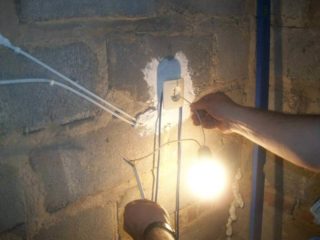
This method is not recommended, since the tester and indicator screwdriver are more accurate and safer methods. But in the absence of tools, you can carry out the following actions, doing everything very carefully:
- Screw the bulb into the socket.
- Hook wires with stripped insulation to the terminals of the cartridge.
- Connect the tested cores to the lamp wires one by one.
This method allows you to find the phase conductor. If the light is on, then one connected core is a phase. Otherwise, the conductors are zero and ground.
It is forbidden to apply other popular methods of verification. They are unsafe and can cause electric shock.
Self-marking
There are times when the marking is erased or it is missing / confused. Then, after dialing each conductor, you should independently designate which core is responsible for what.
If the wire sections are completely replaced, you can purchase the cables of the required color. If it is impossible to acquire a suitable shade, you can make a mark at the ends using colored tape or heat shrink tubing.The rules allow marking the conductor not along its entire length, but only at the points of connection to the buses.











